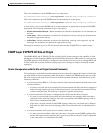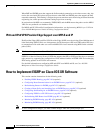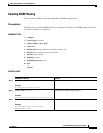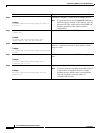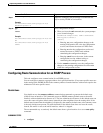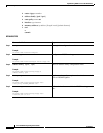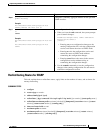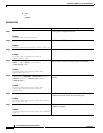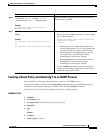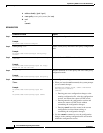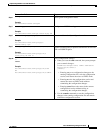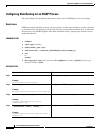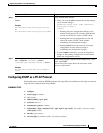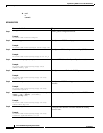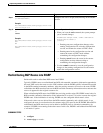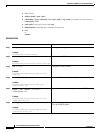
Implementing EIGRP on Cisco IOS XR Software
How to Implement EIGRP on Cisco IOS XR Software
RC-155
Cisco IOS XR Routing Configuration Guide
OL-14356-01
Creating a Route Policy and Attaching It to an EIGRP Process
This task defines a route policy and shows how to attach it to an EIGRP process.
A route policy definition consists of the route-policy command and name argument followed by a
sequence of optional policy statements, and then closed with the end-policy command.
A route policy is not useful until it is applied to routes of a routing protocol.
SUMMARY STEPS
1. configure
2. route-policy name
3. set eigrp-metric bandwidth delay reliability load mtu
4. end-policy
5. end
or
commit
6. configure
7. router eigrp as-number
Step 8
maximum-prefix maximum [threshold] [[dampened]
[reset-time minutes] [restart minutes]
[restart-count number] | [warning-only]]
Example:
RP/0/RP0/CPU0:router(config-eigrp-af)#
maximum-prefix 50000
Limits the number of prefixes that are accepted under an
address family by EIGRP.
Step 9
end
or
commit
Example:
RP/0/RP0/CPU0:router(config-eigrp-af)# end
or
RP/0/RP0/CPU0:router(config-eigrp-af)# commit
Saves configuration changes.
• When you issue the end command, the system prompts
you to commit changes:
Uncommitted changes found, commit them before
exiting(yes/no/cancel)?
[cancel]:
–
Entering yes saves configuration changes to the
running configuration file, exits the configuration
session, and returns the router to EXEC mode.
–
Entering no exits the configuration session and
returns the router to EXEC mode without
committing the configuration changes.
–
Entering cancel leaves the router in the current
configuration session without exiting or
committing the configuration changes.
• Use the commit command to save the configuration
changes to the running configuration file and remain
within the configuration session.
Command or Action Purpose



